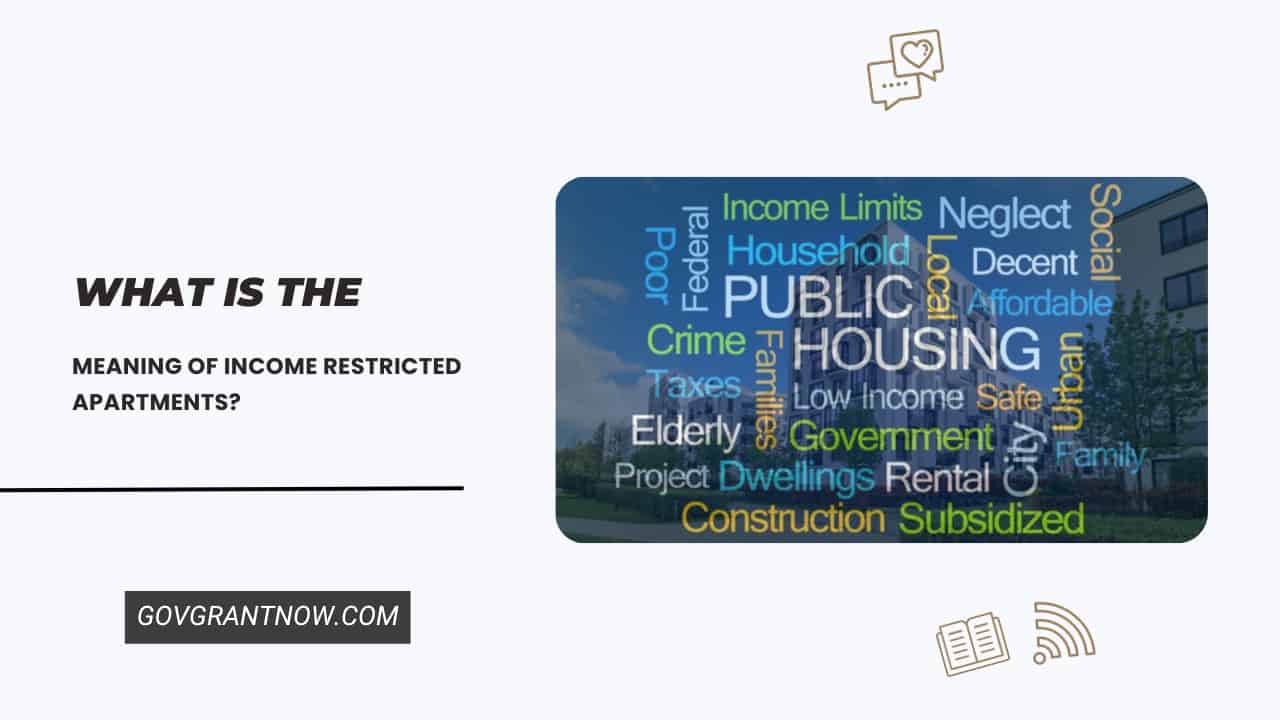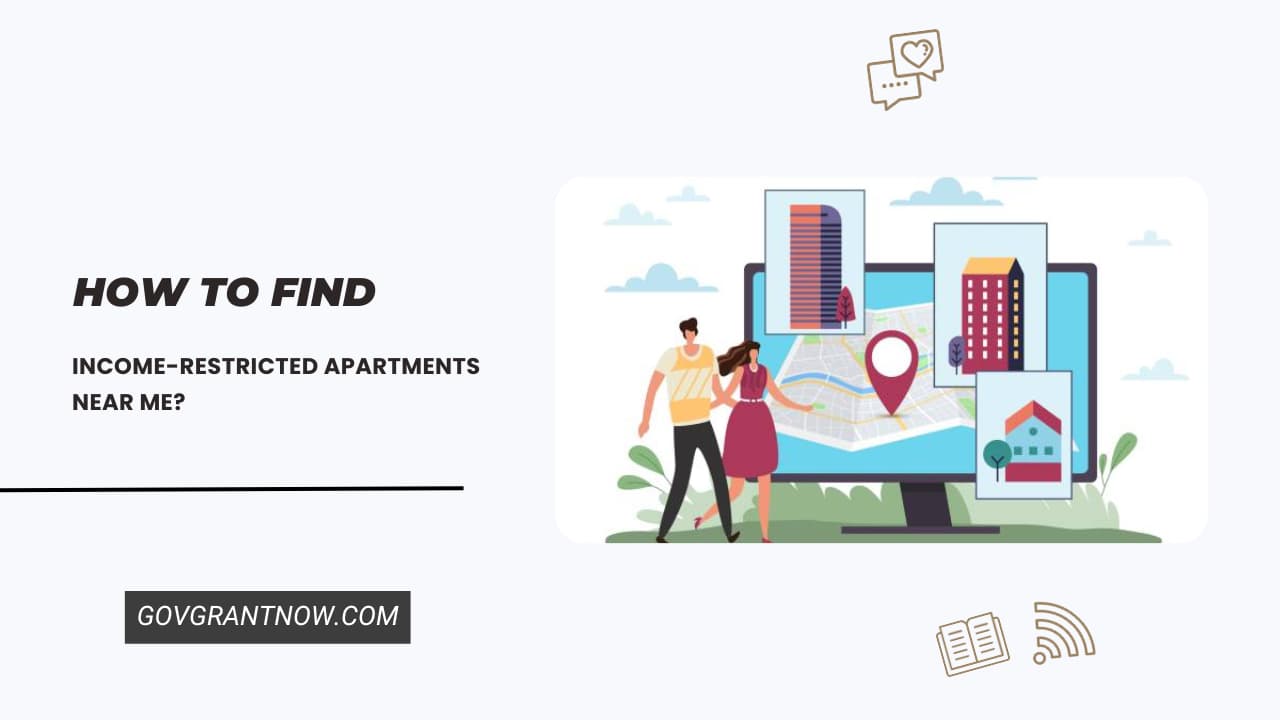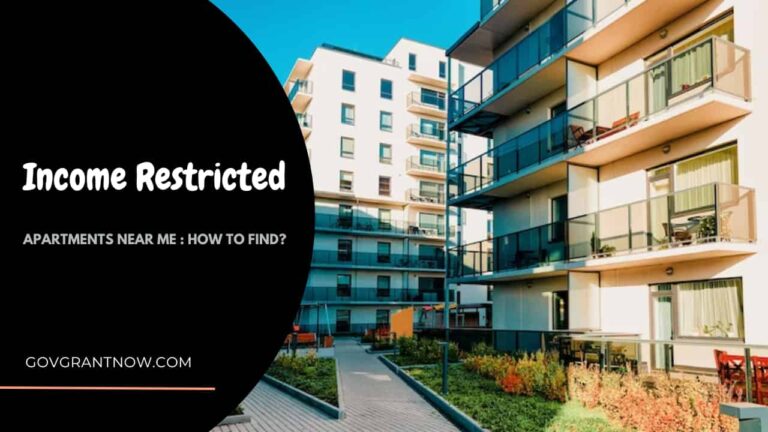Income-restricted apartments offer an affordable housing solution for individuals and families who are looking to live within a specific budget.
These apartments, designed to cater to those with limited income, provide a cost-effective living option without compromising on quality or location.
In this guide, we explore the concept of income-restricted apartments, their benefits, and how to find them in your area, ensuring that you can make an informed decision about your next home.
Whether you are a student, a working professional, or a family on a tight budget, income-restricted apartments present an attractive and feasible living solution.
Table of Contents
What Is the Meaning of Income Restricted Apartments?

Income-restricted apartments meaning of refer to affordable housing designed for individuals and families within certain income brackets.
These apartments are part of programs intended to ensure that quality housing remains accessible and affordable for those who might not be able to afford market-rate rents.
Essentially, to qualify for an income-restricted apartment, a person’s income must fall below a certain threshold, which is often a percentage of the Area Median Income (AMI) for the region.
This ensures that the housing remains affordable for those with limited financial means.
The rent in an income-restricted unit is often lower than the market rate and is adjusted based on the tenant’s income.
The primary goal of income-restricted apartments is to provide safe, decent, and more financially accessible housing options to lower-income households.
These apartments are part of a broader effort to make housing accessible and sustainable for lower-income households.
When you search for income-restricted apartments near me, potential tenants will find a variety of options, ranging from low-income-restricted houses to more spacious income-restricted townhomes.
Each property adheres to specific guidelines set by housing authorities or government programs to ensure fairness and affordability.
Also Read: Houses For Rent No Credit Check No Deposit Near Me
Difference Between Income-Based Apartments Vs Income-Restricted Apartments
Income-based and income-restricted apartments are both forms of affordable housing but differ in how rent is determined.
Income-based apartments calculate rent as a percentage of the tenant’s income, often around 30%, making rent variable and directly tied to income changes.
In contrast, income-restricted apartments have fixed rents that are below market rate and do not fluctuate with income changes.
However, to qualify for these apartments, a tenant’s income must be below certain limits, typically a percentage of the area’s median income.
While both aim to provide affordable housing, income-based apartments adjust with income levels, whereas income-restricted housing offers more rent stability but requires staying within set income limits.
Also Read: Apartments With No Application Fee Near Me
Benefits of Income-Restricted Apartments

Income-restricted apartments, also known as affordable housing, provide several key benefits.
Firstly, they offer lower rent costs, making housing more accessible for individuals and families with lower to moderate incomes.
This affordability is significant in urban areas where the cost of living is typically high.
Secondly, despite the lower costs, these apartments usually maintain quality standards comparable to market-rate housing.
This includes proper maintenance, amenities, and often convenient locations.
Such quality housing at reduced prices provides financial relief to residents, allowing them to allocate more of their income to other essentials like food, healthcare, and education.
Additionally, income-restricted apartments contribute to the stability of housing.
They protect residents from the volatility of the real estate market, especially from sudden rent increases.
This stability is crucial for long-term planning and comfort. Moreover, these apartments play a role in enhancing community diversity.
They allow people from various economic backgrounds to live in neighborhoods that might otherwise be unaffordable, fostering a more inclusive community environment.
Qualifications for Income-Restricted Apartments

Qualifying for income-restricted apartments involves meeting specific criteria, primarily centered around income, but also including other factors such as household size, rental history, and sometimes employment status.
Here are some of the qualifications for income-restricted apartments:
1. Income Requirements:
The most crucial qualification is income level. Your household income must fall below a certain threshold, which is usually set as a percentage of the Area Median Income (AMI) for the region where the apartment is located.
This threshold can vary but is often set at 50% or 60% of the AMI. Some programs may have different levels or tiers of income qualification.
For example, if the AMI is $60,000, an income limit of 60% would mean households earning less than $36,000 per year may qualify.
2. Household Size:
The income limits are typically adjusted based on the size of your household. A larger household might have a higher income limit compared to a single person or a smaller household.
3. Rental History:
Many income-restricted housing programs also look at your rental history. A good rental history, free of evictions or major lease violations, can be important for qualifying.
4. Employment Status:
Some programs may require applicants to be employed or have a steady source of income, though this is not always a strict requirement, especially for elderly or disabled applicants.
5. Background Checks:
Background checks are common, including checking for criminal history. The criteria for disqualification based on criminal history can vary by program and location.
6. Citizenship or Legal Residency:
Applicants may need to prove U.S. citizenship or legal residency status, though this requirement can vary depending on the program and the funding sources.
7. Age and Disability Considerations:
In some cases, especially for senior housing or housing designed for people with disabilities, there may be age or disability requirements.
Also Read: Housing Assistance Grants For Single Moms
How to Find Income-Restricted Apartments Near Me?

Finding income-restricted apartments near you involves a combination of research, utilizing various resources, and sometimes navigating waiting lists.
Here are some easy ways to find income-restricted apartments near me:
1. Online Housing Search Websites:
Utilize websites specifically designed for finding affordable housing. Websites like Apartments.com, AffordableHousingOnline.com, apartmentfinder.com, Trulia.com, and ApartmentList.com offer searchable databases where you can filter results based on income restrictions and other criteria.
2. Local Housing Authority:
Contact your local housing authority. They provide information on income-restricted and subsidized housing in your area. They can also guide you on how to apply and what documentation you’ll need.
3. HUD’s Website:
Visit the U.S. Department of Housing and Urban Development (HUD) website. HUD offers resources for finding affordable apartments and includes a searchable map of federally subsidized housing.
4. Community Organizations:
Reach out to local non-profit organizations or community groups that specialize in housing assistance. They often have lists of available income-restricted apartments and can assist with the application process.
5. Social Services Agencies:
Local social service agencies may have information on income-restricted housing and can help you determine your eligibility.
6. Online Forums and Community Boards:
Sometimes, local community forums or online social media groups can have postings or discussions about available affordable housing.
Also Read: Housing Assistance Grants For Single Fathers
How to Apply for Income-Restricted Apartments?

Applying for income-restricted apartments typically involves a multi-step process that requires careful attention to detail and adherence to specific eligibility criteria.
Here are the steps to apply for income-restricted apartments:
Step 1: Find Suitable Apartments:
Begin by locating income-restricted apartments that meet your needs. Use online resources, local housing authorities, non-profit organizations, and other channels as mentioned in the previous response.
Step 2: Check Eligibility Criteria:
Before applying, ensure you meet the eligibility criteria for income-restricted housing. This usually involves income limits based on the Area Median Income (AMI), along with other factors such as family size, rental history, and sometimes employment status.
Step 3: Gather Required Documentation:
Prepare necessary documents in advance. These typically include proof of income (like pay stubs, tax returns, or benefit statements), identification documents (such as a driver’s license or passport), and possibly references or a rental history report.
Step 4: Complete the Application:
Fill out the application form thoroughly. Be honest and accurate in your responses, as providing false information can lead to disqualification. Some properties might have online applications, while others require paper forms.
Step 5: Submit the Application:
Submit your application along with all required documentation. Make sure to follow the instructions on how to submit these materials, whether it’s online, via mail, or in person.
Step 6: Pay Any Application Fees:
Some places might require an application fee. Be prepared to pay this fee when you submit your application.
Step 7: Wait for Application Processing:
After submission, there will be a processing period where your application and documents are reviewed. This process can take several weeks or even months, depending on the demand and the number of applications.
Step 8: Undergo Interviews and Checks:
You might be called for an interview as part of the application process. Additionally, the property management might conduct background and credit checks.
Step 9: Join a Waiting List if Necessary:
In many cases, especially in high-demand areas, you might be placed on a waiting list after your application is accepted. Regularly follow up on your status.
Step 10: Acceptance and Lease Signing:
Once an apartment becomes available and you are next on the list, you will be notified. At this point, you will review and sign a lease agreement, which outlines the terms of your tenancy.
Also Read: Home Repair Grants for the Disabled People
Challenges and Considerations for Obtaining Income-Restricted Apartments
When it comes to finding and living in income-restricted apartments, there are several challenges and considerations to keep in mind:
- Limited Availability: One of the biggest challenges is the limited availability of income-restricted apartments, especially in high-demand urban areas. This can lead to long waiting lists and a competitive application process.
- Income Eligibility Requirements: Staying within the required income limits can be tricky, especially if your income fluctuates. If your income increases beyond the set limits, you might lose your eligibility, which can create a dilemma for those striving for higher earnings.
- Quality and Maintenance of Properties: While many not income-based apartments are well-maintained, some might suffer from neglect or lower quality due to limited funding and resources. It’s important to thoroughly inspect any potential apartment and research the property management’s reputation.
- Location Constraints: Income-restricted apartments might not always be located in your preferred area, which can impact commute times, access to services, and overall quality of life.
- Changing Family Dynamics: If your family size changes, such as through marriage, childbirth, or a family member moving out, it can affect your eligibility or the size of the apartment you qualify for.
- Renewal and Recertification Requirements: Tenants often need to recertify their income and family size annually, which can be a source of stress and uncertainty, especially if there have been significant changes in your circumstances.
- Community Resources and Services: Depending on the location, community resources, amenities, and services like schools, parks, and shopping might be limited, which can impact your living experience.
- Lease Terms and Restrictions: Be aware of lease terms and any restrictions, such as limitations on guests, pet policies, and rules regarding the use of common areas.
Suggested Post :-
Conclusion:-
Income-restricted apartments represent a vital segment of the housing market, offering affordable, quality living spaces for individuals and families with limited income. They play a crucial role in ensuring that decent housing remains accessible to those who might not afford market-rate rents.
The eligibility criteria, such as income limits and household size, are designed to maintain fairness and target those in genuine need. Despite the challenges like limited availability and the extensive documentation process, income-restricted apartments are an indispensable resource for many.
As urban areas continue to grow and the cost of living rises, the importance of these housing options cannot be overstated. Those seeking affordable housing should consider income-limited apartments as a viable option, especially when exploring opportunities within their local communities.
Frequently Asked Questions:
What Are Income Restricted Apartments?
Income Restricted Apartments are housing units offered at reduced rates to individuals and families whose income falls below a certain threshold, typically a percentage of the area’s median income.
Do Income Restricted Apartments Check Credit?
Yes, income-restricted apartments usually conduct a credit check on potential tenants. This is part of their standard application process to assess financial reliability. However, criteria for acceptable credit may vary by landlord or management company, and some might be more flexible, especially in income-restricted housing scenarios.
How Do Income-Restricted Apartments Work?
- Income Requirements: Tenants must meet specific income requirements, usually a percentage of the Area Median Income (AMI). These requirements ensure that only those who fall under a certain income level can apply.
- Rent Calculation: Rent is often based on a percentage of the tenant’s income, ensuring affordability. This can be a fixed percentage or a tiered system based on income brackets.
- Application Process: Prospective tenants must provide proof of income and undergo a standard application process, which often includes a credit check.
- Regular Recertification: Tenants typically need to recertify their income annually to remain eligible for the apartment.
- Government Subsidies: Many of these apartments are subsidized by government programs to maintain lower rents.
How Do Income-Restricted Apartments Verify Income?
Income-restricted apartments typically require the following for income verification:
- Documentation: Applicants must provide proof of income, such as pay stubs, tax returns, or bank statements.
- Employer Verification: They may contact employers directly to confirm income details.
- Other Income: Proof of any additional income sources, like government benefits, is also required.
- Annual Recertification: Tenants usually need to recertify their income each year to maintain eligibility.
How to Qualify for Income-Restricted Apartments?
- Meet Income Limits: Your income must be within certain limits, usually a percentage of the Area Median Income (AMI) for your location.
- Provide Proof of Income: Submit recent pay stubs, tax returns, or other documents to verify your income level.
- Pass a Credit and Background Check: Most properties conduct these checks to assess financial reliability and rental history.
- Comply with Other Requirements: Some properties may have additional criteria like family size or student status.
- Complete the Application Process: Fill out the application forms accurately and provide all required documentation.
Income-Based Vs Income-Restricted Apartments
1. Income-Based Apartments: Rent in these apartments is typically a percentage of your income, meaning the rent amount adjusts based on how much you earn. This approach ensures that tenants pay an amount that aligns with their financial capability.
2. Income-Restricted Apartments: These have fixed rent prices, but eligibility to live in them is based on your income. Your income must fall below a certain limit, often determined by the Area Median Income (AMI) of the region. The rent doesn’t change with fluctuations in your income.
What Does “Income Restrictions Apply” Mean?
When a housing listing says “income restrictions apply,” it means that to qualify for renting that property, your income must be within certain limits. These limits are typically set in relation to the Area Median Income (AMI) of the region. The purpose is to ensure that the housing remains affordable for individuals or families with lower or moderate incomes. This restriction is common in affordable housing programs.
Are Pets Allowed in Income-Restricted Apartments?
Whether pets are allowed in income-restricted apartments varies by property. Each apartment complex or landlord sets their own pet policy. Some may allow pets with certain restrictions on breed, size, or number, while others might not permit pets at all. It’s important to check the specific pet policy of the income-restricted apartment you’re interested in.
What Is the Income Limit for Income-Restricted Apartments?
The income limit for income-restricted apartments typically depends on the Area Median Income (AMI) of the location and the specific guidelines of the housing program. Generally, these limits are set at a percentage of the AMI – often 50%, 60%, or 80%.
For example, if the AMI is $50,000, an apartment with a 60% income limit would require that your household income not exceed $30,000 annually. However, these limits can vary widely based on location, the specific housing program, and other factors. It’s essential to check the specific requirements of each property.
Can I Apply for Income-Restricted Apartments If I’m a Student?
Yes, students can apply for income-restricted apartments, but there may be special considerations or restrictions. Some income-restricted housing programs have specific rules regarding student eligibility, often related to the student’s income source and whether they’re considered independent or dependent.
